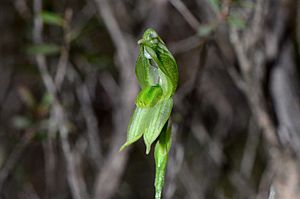Mallee leafy greenhood facts for kids
Quick facts for kids Mallee leafy greenhood |
|
|---|---|
 |
|
| Pterostylis prasina growing in the Little Desert National Park | |
| Scientific classification | |
| Genus: |
Pterostylis
|
| Species: |
prasina
|
| Synonyms | |
|
Bunochilus prasinus D.L.Jones |
|
The Pterostylis prasina, often called the mallee leafy greenhood, is a type of orchid. It belongs to the orchid family, known as Orchidaceae. This plant is found only in southern Australia. It is quite common in parts of Victoria and South Australia.
When the plant is not flowering, it has a group of leaves shaped like a circle, called a rosette. But when it flowers, the rosette disappears. Instead, it grows up to eight pale green flowers with darker green lines. These flowers are also a bit see-through. They have a light green lip, called a labellum, with a darker line down the middle.
Contents
All About the Mallee Greenhood
The Mallee leafy greenhood is a plant that grows from an underground storage part called a tuber. It is a perennial plant, which means it lives for more than two years. It is also a deciduous plant, meaning it loses its leaves at certain times of the year.
What the Plant Looks Like
When the plant is not flowering, it has a rosette of three to five dark green leaves. These leaves can be egg-shaped or spear-shaped. They are about 7 to 50 millimeters (0.3 to 2 inches) long and 4 to 15 millimeters (0.2 to 0.6 inches) wide. They grow on a thin stalk that is 20 to 50 millimeters (0.8 to 2 inches) long.
When the plant flowers, it does not have the rosette. Instead, it grows a flowering stem that can be 70 to 500 millimeters (2.8 to 20 inches) tall. This stem has four to seven dark green leaves. These leaves are 10 to 60 millimeters (0.4 to 2.4 inches) long and 3 to 9 millimeters (0.1 to 0.4 inches) wide.
The Flowers of the Greenhood
The flowers are pale green and somewhat see-through, with darker green lines. They are about 9 to 12 millimeters (0.4 to 0.5 inches) long and 4 to 6 millimeters (0.16 to 0.24 inches) wide.
The top part of the flower, called the dorsal sepal, and the petals are joined together. They form a hood, or "galea," over the central part of the flower called the column. The dorsal sepal has a short brownish tip.
The lateral sepals point downwards. They are 9 to 15 millimeters (0.4 to 0.6 inches) long and 4 to 6 millimeters (0.16 to 0.24 inches) wide. They are joined together for part of their length and also have brownish tips.
The labellum (or lip) of the flower is light green. It is 5 to 7 millimeters (0.2 to 0.3 inches) long and about 2 millimeters (0.08 inches) wide. It has a darker green line down its middle and a small bump near its base. Mallee leafy greenhoods usually flower from July to September.
How the Greenhood Got Its Name
The Mallee leafy greenhood was first officially described in 2006. A botanist named David Jones gave it the name Bunochilus prasinus. He published this description in a scientific book called Australian Orchid Research. He studied a plant sample found near Sherlock.
Then, in 2007, another botanist named Gary Backhouse changed its name to Pterostylis prasina. The second part of the name, prasina, comes from a Latin word. It means "green" or "leek-green," which describes the color of the flowers.
Where the Greenhood Lives
Pterostylis prasina is a common plant. It is found in the Little Desert and Big Desert areas of Victoria. It also grows in the Murray, Yorke Peninsula, South Eastern, and possibly Eyre Peninsula areas of South Australia.
This orchid likes to grow in sandy soil. You can often find it among plant litter, which is made of fallen leaves and twigs, under small trees and shrubs.

